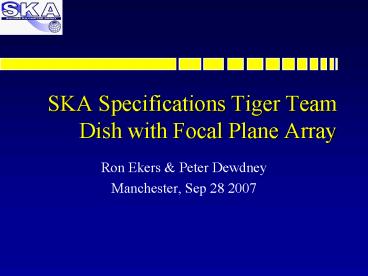SKA Specifications Tiger Team Dish with Focal Plane Array - PowerPoint PPT Presentation
1 / 19
Title:
SKA Specifications Tiger Team Dish with Focal Plane Array
Description:
These are not needed to generate the image. Redundant Fourier components ... John Kot, Christophe Granet. But note that for a given size PAF the FoV ~ 1/F (MK) ... – PowerPoint PPT presentation
Number of Views:47
Avg rating:3.0/5.0
Title: SKA Specifications Tiger Team Dish with Focal Plane Array
1
SKA Specifications Tiger TeamDish with Focal
Plane Array
- Ron Ekers Peter Dewdney
- Manchester, Sep 28 2007
2
Radio Telescope Imagingimage v aperture plane
?
Active elements A/?2
Dishes act as concentrators Reduces FoV Reduces
active elements Cooling possible
Increase FoV Increases active elements
3
Redundancy (1)
1unit 5x 2units 4x 3units 3x 4units 2x 5units
1x 15
n(n-1)/2
1 2 3 4 5
6
4
Redundancy (2)
1unit 1x 2units 1x 3units 1x 4units 1x 5units
0x 6units 1x 7units 1x etc
1 2 3 4 5
6 7 8
5
Dynamic Rangesparse or filled arrays
- Aperture plane arrays can be made sparse
- They measure redundant Fourier components
- These are not needed to generate the image
- Redundant Fourier components improve dynamic
range - Optical telescopes have worse aperture errors
than Radio - So why do they have better dynamic range
- Its all in the redundant Fourier components
- Image plane arrays cannot be sparse
- You miss information
- Over sampling (many elements/beam) will improve
dynamic range - Compact core of SKA has a lot of redundancy and
should have good dynamic range
6
Multibeam Dishes or Multiple Dish Arrays
Structural ? signal processing cost
7
Phased Array Feeds
- Focal plane arrays
- Phased Array Feeds (PAF)
- ASTRON Vivaldi
- ATNF Checkerboard
- Cluster feeds
- Parkes Multibeam
8
Some PAF designs
9
Phased Array Feed Dish Solutions
- Provides mechanism for science-based optimization
of Ae/Tsys SS independently. - A risk mitigator for expensive antennas?
- Substitutes FoV for Ae/Tsys in survey speed
equation (Ae/Tsys)2 ?FOV. - Success depends on cost of PAFs versus antenna
cost. - Moores Law cost component to beamformer gt
reduces over time. - In the long run may be the only way to get high
survey speed. - Development time could be an issue.
- Possibly need to future-proof antennas and
other things to permit substitution, especially
if Pathfinders develop directly into SKA. - More control over feed pattern
- potentially be able to reduce polarization
systematics and increase efficiency gt lower
system costs. - Can optimise beam for science (sidelobes v G/T v
G) - Tsys potentially dominant technical problem.
- Cyro-cooling may be expensive (capital
operating). - At lt1.4 GHz promising uncooled solutions are
being developed.
10
SPF v PAF Optimised for Survey Speed
- PAF
- Tsys35K
- 3GHz PAF
- 25GHz dish
- SPF (18K)
- Tsys 18K
- Single Rx
- Max 25GHz
11
LNSD v PAF Optimised for Survey Speed
- PAF
- Tsys35K
- 3GHz PAF
- 25GHz dish
- SPF (18K)
- Tsys 18K
- Single Rx
- Max 25GHz
- SPF (26K)
- Tsys 26K
12
PAF cost break down Optimised for Survey Speed
- SSFOM3.2.108
- Antenna to 25GHz
- 3GHz PAF
13
LNSD cost break down Optimised for Survey Speed
SSFOM3.2.108 Antenna to 25GHz
14
Survey Speed or Sensitivity?
15
Sensitivity v Survey Speed for const cost
- FoV set by
- 15m dish PAF size
- SPF dish size
- Tsys 35K
- ( for both )
- SSFoM
- FoV(A/T)2
- assumes same bandwidth
- Calc at 1.4GHz
- Bandwidth
- 375 MHz for both
- Computing
- 5km imaging
16
Sensitivity v Survey Speed for const cost
- FoV set by
- 15m dish PAF size
- SPF dish size
- Tsys 35K
- ( for both )
- SSFoM
- FoV(A/T)2
- assumes same bandwidth
- Calc at 1.4GHz
- Bandwidth
- 375 MHz for both
- Computing
- 5km imaging
17
Sensitivity v Survey Speed for const cost
- FoV set by
- 15m dish PAF size
- SPF dish size
- Tsys 35K, 25K
- SSFoM
- FoV(A/T)2
- assumes same bandwidth
- Bandwidth
- 375 MHz for both
- Computing
- 5km imaging
18
Challenges for PAFs
19
Dual reflector
- Inspired by
- Evidence that FPA wanted F/Dgt0.4
- Weight for possible cooling
- Desire for wide fielding to support multiple
feeds/FPAs - Possible large reduction in feed support blockage
dynamic range - Options considered
- Cassegrain, Schwarzchild, shaped to optimise FOV
- Problems
- Sub-reflector blockage - 7
- Sub-reflector spillover - 7
- Cf perhaps 10 loss due to FPA with F/D0.4 prime
focus - Multiple reflections are a potential problem but
seem OK - work proceeding
John Kot, Christophe Granet
But note that for a given size PAF the FoV 1/F
(MK)































